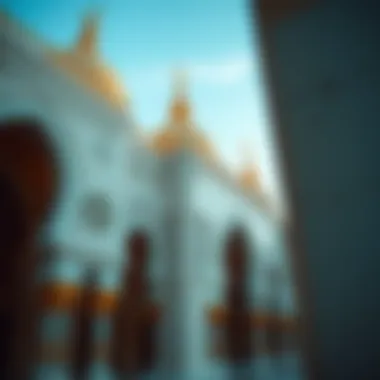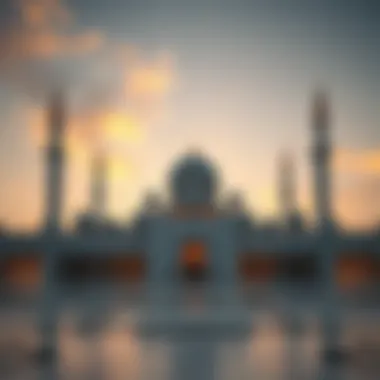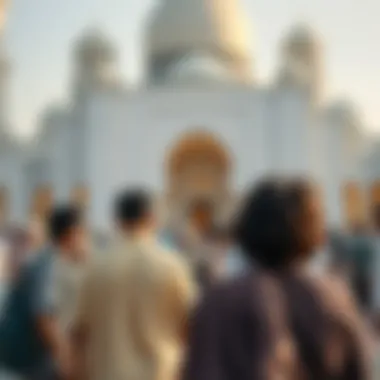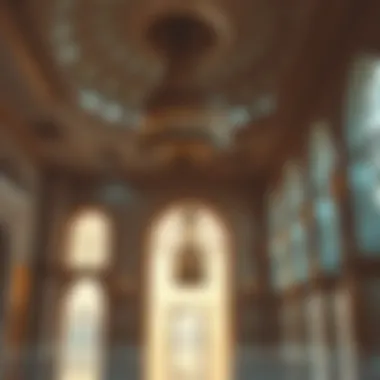Exploring the Jumeirah Mosque: An Architectural Icon


Intro
Nestled amidst the modern skyline of Dubai, the Jumeirah Mosque serves not just as a house of worship, but as a vibrant emblem of the city’s cultural fabric. This mosque, noted for its intricate architecture, is an inviting space for both worshippers and visitors seeking to expand their understanding of Islamic traditions. Its design showcases the beauty of Islamic art, with minarets reaching skyward and intricate carvings adorning its façade.
The mosque operates as a bridge between cultures, opening its doors to people from all walks of life. Its welcoming philosophy centers on education, with guided tours that shed light on the practices and values of Islam. As Dubai continues to grow as a global hub, the Jumeirah Mosque shines as a beacon of tolerance and understanding. This article will explore the architectural details, cultural significance, and the very essence of what makes this mosque an integral part of not just Dubai, but the broader context of cross-cultural dialogue.
In examining the mosque's rich history, we will also consider the role it plays in fostering an appreciation for Islamic practices among those who may approach it with curiosity or skepticism. With insights into visitor experiences and educational initiatives, we aim to highlight how this monument is more than stone and mortar; it is a living testament to the spirit of Dubai and a testament to its commitment to inclusivity and education.
Prologue to Jumeirah Mosque
The Jumeirah Mosque stands as a radiant example of Islamic architecture in Dubai, making it not just a place of worship but a cultural icon that invites curiosity and respect. Understanding its significance offers insight into not only the architectural prowess of the region but also the rich cultural tapestry that characterizes Dubai. This mosque functions as a beacon of knowledge for both residents and visitors alike, bridging gaps between diverse communities and their varying perceptions of Islam.
Geographical Location
Nestled amidst the bustling landscape of Dubai, the Jumeirah Mosque is strategically located in the heart of the Jumeirah district. It sits near the pristine shores of the Arabian Gulf, offering breathtaking views that complement its architectural beauty. Just a stone's throw away from popular tourist attractions and upscale neighborhoods, this mosque is more than a religious site; it serves as a landmark that shapes the identity of its surroundings. Accessibility is also an advantage for visitors, with the Dubai Metro and local transport systems conveniently connecting travelers to this serene spot. The mosque is not only a geographical point of interest but also a cultural oasis amidst the fast-paced lifestyle of urban Dubai.
Historical Background
The Jumeirah Mosque, completed in 1979, reflects a blend of traditional Islamic designs with modern interpretations, marking a turning point in Dubai’s architectural evolution. Unlike many mosques that are often less accessible to non-Muslims, the Jumeirah Mosque was built with the intention of fostering understanding and engagement between cultures. Its design is based on the Fatimid style of architecture, characterized by intricate detailing and symmetry, which is a hallmark of Islamic art. The mosque often hosts educational programs and guided tours, created to encourage dialogue and provide a deeper appreciation of Islamic traditions. This open approach underscores a historical commitment to inclusivity, making it a vital part of Dubai's socio-cultural landscape.
"The Jumeirah Mosque not only stands as a testament to Islamic architectural elegance but also embodies Dubai's commitment to cultural exchange."
Visitors are encouraged to immerse themselves in the history that envelopes the mosque, taking time to reflect on how its purpose has transcended mere worship and evolved into a platform for interfaith discussions. Each brick and stone in this mosque tells a story of the past, shaping the present narrative of Dubai as a city characterized by diversity and acceptance.
Architectural Features of Jumeirah Mosque
The architectural features of Jumeirah Mosque hold significant value, not only in terms of aesthetic appeal but also for their embodiment of cultural and religious principles. This mosque serves as a fine example of modern Islamic architecture, thereby representing a bridge between tradition and contemporary design. The factors that contribute to the mosque's unique architectural framework include Islamic architectural styles, construction materials and techniques, as well as distinctive interior design elements.
Islamic Architectural Styles
Jumeirah Mosque stands out as a beacon of Islamic architectural styles that merge aesthetics with functionality. Characterized by a blend of traditional designs and modern influences, the mosque features the classic Fatimid architectural style, which is prominently displayed in its grand dome and towering minarets. The striking symmetrical design evokes a sense of harmony and balance, which is central to Islamic aesthetics. What sets this mosque apart is its openness to non-Muslims, offering a rare glimpse into the beauty of Islamic architecture.
- Dome: The dome, a common feature in Islamic mosques, symbolizes the vault of heaven. In Jumeirah Mosque, it is adorned with intricate patterns, reflecting the dedication to craftsmanship.
- Minarets: The two minarets elegantly rise from the structure, not solely serving as architectural elements but also as visual markers that guide the faithful.
- Arched doorways: These form an inviting entrance, leading not just to a physical space but to a deeper understanding of community and faith.
Construction Materials and Techniques


The construction materials used in the Jumeirah Mosque reveal a thoughtful approach to sustainability and local heritage. The use of sandstone lends a warm, earthy tone to the structure, harmonizing it with the desert landscape around. Local craftsmen played a pivotal role in its construction, employing time-honored techniques that have been passed down through generations.
- Stone Carving: Witness the meticulous stone carvings that adorn the exteriors and interiors. This craft not only highlights artistic skill but also represents the devotion of artisans.
- Glass: Colored glass windows filter sunlight into the prayer hall, bathing the interior in a spectrum of colors while maintaining privacy.
- Traditional Techniques: The use of traditional building techniques ensures that the mosque remains in touch with its cultural roots, allowing a conversational narrative between the past and present to unfold.
Interior Design Elements
The interior design of Jumeirah Mosque encapsulates the essence of Islamic spirituality and artistic expression. Upon stepping inside, visitors are greeted by an atmosphere of tranquility created by various elements that come together in harmony.
- Prayer Hall: The expansive prayer hall features an intricate carpet, its colors and patterns symbolizing unity and diversity within the community.
- Ornate Calligraphy: Walls adorned with elegant Arabic calligraphy, containing verses from the Qur'an, serve not only as decorative elements but also as a source of inspiration and reflection for worshippers.
- Chandeliers: Eye-catching chandeliers hang gracefully from above, illuminating the space while adding a touch of opulence to the overall ambiance.
"Jumeirah Mosque is not just an architectural marvel; it's a living entity that communicates faith and community through its very structure."
Cultural Significance
The Jumeirah Mosque is more than just a stunning example of Islamic architecture; it serves as a cornerstone of cultural significance in Dubai. One could argue that its role transcends mere aesthetics and delves into the very fabric of society. As a spiritual hub, it holds immense importance for local Muslims while also acting as a cultural bridge for non-Muslims. Understanding this dual role provides insights into how the mosque fosters community spirit and promotes cultural understanding.
Role in the Community
At the heart of any thriving society lies its community, and the Jumeirah Mosque plays a pivotal role in knitting together the local populace. This mosque serves not just as a place of worship, but as a multi-functional facility where cultural and social events unfold.
For instance, during Ramadan, the mosque opens its doors to host iftar meals, allowing families and friends to come together, share food, and experience the essence of community spirit. The mosque organizes various events throughout the year geared toward promoting social bonds and cultural exchange, allowing diverse groups to engage in activities—from art exhibitions to charity drives.
- Cultural Events: Celebrations of Islamic holidays, like Eid, see increased participation from the community, reinforcing the shared values that bind different cultural backgrounds.
- Educational Programs: Workshops are often held here, focusing on Islamic teachings, enhancing knowledge, and dismantling misconceptions about the Islamic faith.
- Outreach Initiatives: The mosque collaborates with other local organizations to support social causes, demonstrating a proactive approach to social responsibility.
In this way, the Jumeirah Mosque not only enriches the lives of individuals but also reinforces a cohesive community approach, where everyone feels included.
Interfaith Dialogue and Education
Given the cosmopolitan nature of Dubai, it’s crucial to have spaces that allow for dialogue and learning across different faiths. The Jumeirah Mosque shines in this regard by serving as a venue for interfaith dialogues. Such initiatives are essential for fostering understanding and respect among different religious and cultural backgrounds.
The mosque’s initiative of Guided Information Tours is pivotal in this mission. These tours invite individuals from all walks of life to learn about Islam through firsthand experiences. It’s not unusual for groups from various faiths to join together for these tours, and many participants come away with a newfound respect for Islamic practices.
- Fostering Understanding: The mosque actively encourages questions, dispelling myths and providing a platform for open discussions about faith and religion.
- Community Workshops: These sessions involve sharing religious texts and phrases with participants, aiming to explore spiritual principles together.
- Collaborative Events: By hosting events that include speakers from multiple faiths, the mosque becomes a beacon of tolerance and cooperation.
Fact: A study conducted by the University of Dubai found that interfaith initiatives can significantly reduce prejudice, making it a matter of social importance.
Through these activities, the mosque plays an integral role in promoting dialogue, education, and ultimately understanding between cultures, making it clear that faith can be a unifying factor in a world often rife with division.


In summary, the cultural significance of the Jumeirah Mosque extends far beyond its architecture. Its role in the community and its dedication to interfaith dialogue are crucial components that not only uplift the spirits of those within its walls but also enrich the broader societal framework of Dubai.
Visiting the Jumeirah Mosque
Visiting the Jumeirah Mosque is more than just a mere sightseeing opportunity; it offers a doorway into understanding Islamic culture and traditions. This mosque is unique not just because of its breathtaking architecture, but it also serves as a point where locals and visitors from all walks of life come together to bridge cultural gaps. For tourists, it's a way to gain insight into the religious practices of the region, which can sometimes be shrouded in misunderstanding or myths. The mosque's welcoming approach to visitors emphasizes the importance of respect, curiosity, and dialogue in fostering mutual understanding.
Visitor Guidelines
When planning a visit to the Jumeirah Mosque, it's crucial to adhere to certain guidelines that preserve the mosque’s sanctity and provide a respectful environment for prayer. Visitors are typically required to dress modestly, covering shoulders and knees, whether they are men or women. Some might find it helpful to know that traditional clothing, such as the abaya for women and the kandura for men, can be rented nearby if needed. Photography is usually allowed outside and in specific areas, but discretion should be exercised in prayer halls. Visitors should also remain quiet and respectful, keeping in mind that this is a place of worship.
“Respectful engagement enriches the interaction – it’s not just about observing, it’s about understanding.”
Guided Tours and Educational Programs
For those eager to delve deeper into the mosque's significance, guided tours and educational programs are available. These tours often include experienced guides who narrate the rich history and architecture of the mosque, explaining the intricate designs that reflect Islamic artistry. Participants will learn about the symbolism behind various features, such as the minarets and domes, which are representative of the Islamic faith. Additionally, educational programs often flex out into broader topics of Islamic traditions and teachings, creating a rich learning experience. Many tours also allow time for questions, encouraging a dialogue that can further deepen one's appreciation for the culture. Some pre-scheduled programs include sessions on Islamic art and the history of the region, making it a learning hub rather than just a place of worship.
Best Times to Visit
Timing can greatly impact the experience when visiting the Jumeirah Mosque. Ideally, visiting during the early morning or late afternoon offers a more serene atmosphere with fewer crowds. This is particularly true during weekdays. Moreover, Ramadan is a special time to witness unique activities, including nightly prayers and community events, though it's important to remember that visiting hours might change during this sacred month. Notably, the cooler months from October to March mark the peak tourist season in Dubai, making this an excellent time for exploration but also a busy period. Ultimately, whether you're seeking peace in the early hours or vibrant community interaction in the evenings, planning your visit with these considerations in mind is worthwhile.
Role of Jumeirah Mosque in Promoting Understanding
The Jumeirah Mosque stands out in Dubai not just as an architectural beauty, but as a crucial player in fostering understanding between different cultures. The mosque is strategically positioned to welcome visitors from all walks of life. It serves as a bridge between the Islamic faith and the wider global community, making it a vital cultural landmark.
Cultural Exchange
Cultural exchange at Jumeirah Mosque is more than just a series of tours; it's a heartfelt interaction aimed at quenching curiosity and dispelling stereotypes. The mosque opens its doors to those who may know little about Islam and its practices. Each guided tour is an invitation, encouraging curiosity and dialogue that transcends simple observation.
When visitors engage with the mosque's guides, they not only learn about Islamic beliefs but also about the shared values that unite different cultures. This is where the magic of cultural exchange occurs. As the guides share stories and practices, they're actually weaving a rich tapestry of understanding that highlights both differences and commonalities. This approachable format allows for genuine inquiries and open discussions, allowing misconceptions to fade away and knowledge to flourish.
Importantly, cultural exchange fosters empathy among visitors. As they learn about daily prayers, festivals, and traditions, visitors find themselves considering different perspectives. It's like looking through a different lens, one that reveals the beauty in diversity and the importance of respect. Such exchanges could lead to friendships and collaborations well beyond the mosque's walls.
Community Events and Activities
The Jumeirah Mosque hosts a variety of community events designed to deepen relationships within the community and beyond. These activities provide avenues for interaction among various ethnicities, religions, and ages, creating a vibrant cultural hub.
Some notable events include:


- Open doors every Friday for mosque tours aimed at both residents and tourists.
- Workshops and lectures that delve into topics like Islamic art, architecture, and history.
- Interfaith sessions that gather members from various faiths to discuss shared values and cultural practices, creating a dialogue that enriches everyone involved.
Such gatherings turn the mosque into a locale of unity and fellowship, fostering a spirit of community that resonates throughout Dubai. Each event serves not only as an educational opportunity but also as a platform for dialogue on pressing issues that often polarize societies. Here, participants can voice their opinions, hear others’ perspectives, and find common ground.
Overall, Jumeirah Mosque is pivotal in promoting understanding, acting as a cultural lighthouse in the bustling diversity of Dubai. This role underscores the mosque’s significance as a site where belief systems meet and flourish, and where individuals leave a little bit more enlightened than when they arrived.
Challenges and Misconceptions
When it comes to understanding the Jumeirah Mosque, several challenges and misconceptions arise that can skew both visitors' perceptions and the broader discourse surrounding the mosque itself. Acknowledging these challenges is paramount, as it not only sheds light on common misinterpretations, but also promotes a more nuanced understanding of Islamic culture and the mosque's role within the community.
This exploration embraces the intricate relationship between architecture, faith, and local culture, ultimately revealing how these dynamics interact within the setting of the Jumeirah Mosque. To comprehend its significance fully, one must first navigate through the murky waters of misinformation and stereotype.
Common Misunderstandings
Many misunderstandings about the Jumeirah Mosque stem from generalizations about Islam and Muslim practices. One prevalent misconception is that all mosques are identical; few grasp the unique architectural features or the cultural relevance of the Jumeirah Mosque specifically. Its design is influenced by various Islamic styles, notably the influence of Mughal architecture. This is quite different from the traditional designs found in other Islamic nations.
Visiting tourists often think that mosques are exclusive spaces for worship only. In reality, the Jumeirah Mosque opens its doors for educational tours, making it a hub for learning and interfaith dialogue. This aspect is crucial, as it demonstrates the mosque's intention to bridge gaps and foster understanding.
Another misunderstanding is rooted in cultural practices. Some people assume that entering a mosque is a daunting affair laden with restrictive rules. Yet, at the Jumeirah Mosque, there is a distinct effort to welcome visitors, regardless of their background. Non-Muslims can freely enter, with a dress code that is more about respect than rigidity. This welcoming nature stands to challenge stereotypes of Islam being unapproachable.
Addressing Cultural Sensitivities
Addressing cultural sensitivities is a delicate but essential part of promoting a deeper understanding of the Jumeirah Mosque. The teachings within these walls often promote peace, tolerance, and coexistence. However, the fast pace of globalization and frequent misrepresentation in assorted media can lead to a sense of wariness. To mitigate this, educators and guides at the mosque actively encourage respectful interactions and open dialogues.
Visitors can engage in discussions about Islamic tradition and practices during guided tours. This makes it crucial for both parties to embrace openness and mutual respect. Additionally, informational brochures available on-site break down complex topics into digestible content, appealing to those who might feel intimidated by the culture.
In essence, tackling misconceptions and addressing sensitivities goes hand in hand. The Jumeirah Mosque, far from being a secluded sanctuary, serves as a vibrant community center and a beacon of understanding. Such dialogues not only enrich visitors’ experiences but also dismantle the walls of ignorance that often perpetuate division in a diverse society.
Culmination
Examining the Jumeirah Mosque provides crucial insights into not just Islamic architecture but also the cultural tapestry of Dubai. This mosque acts as a vibrant focal point where faith, history, and community converge, revealing layers of significance that extend far beyond its brick and mortar. For investors, developers, sellers, and other stakeholders in Dubai's real estate scene, an understanding of such culturally rich landmarks can inform broader investment strategies and community planning initiatives.
Reflections on Jumeirah Mosque's Impact
The Jumeirah Mosque’s influence stretches into various aspects of everyday life and socio-economic development in Dubai. Here are some key reflections:
- Cultural Appreciation: The mosque serves as a venue where visitors can learn about Islamic traditions and local customs. Educational programs are tailored to foster understanding and respect, bridging the gap between different cultures. This makes it a vital asset in promoting social harmony in a city known for its diverse populations.
- Community Engagement: As a center for gatherings and festivals, the mosque plays a significant role in community cohesion. It engages people from all walks of life in various activities, making it more than just a place of worship; it’s a hub for socializing that enriches the local culture.
"The Jumeirah Mosque is a testament to the welcoming nature of Dubai, bridging cultural divides and enriching its urban fabric."
- Tourism and Economic Benefit: The mosque attracts tourists eager to explore its stunning architecture and learn about Islamic culture. This influx of visitors boosts the local economy, demonstrating how cultural landmarks can contribute to broader economic strategies.
- Symbol of Tolerance: In today’s global landscape, the mosque stands as a symbol of tolerance and interfaith dialogue. It underscores the importance of understanding and respect among different faiths, an essential narrative in a world often marred by division.
In essence, the Jumeirah Mosque is not merely an architectural marvel but a symbol of Dubai’s commitment to cultural education and community spirit. By fostering understanding and appreciation for diverse practices, it helps shape both the local identity and the city’s image on the global stage.











